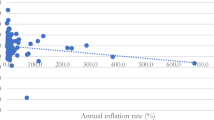Abstract
It has been presumed that an increase in economic growth rates automatically intensifies inflation processes, which provoke sensitivity among mass layers of the population. However, manifestations of interdependence between growth and inflation are different in different economic systems. Of importance are the degree of the maturity of the economic organism, its historical experience, and the sociopolitical context. Financial instability is a fundamental qualitative characteristic of the capitalist economy with its complex branched system of institutions. The suppression of inflation implies disciplinary actions from above, regulating the economic behavior of various groups of society. Rigid control over inflationary processes is characteristic of “late start” societies and, even more so, of states of the third wave of modernization, particularly India. Inflation in its acute forms turned out to be a result of the administration’s policy intended to form a middle class. The author of this article holds that the approach of India’s authorities to inflation problems is based on three strategic principles: measures to normalize circulation, to protect the poorest layers of the population from the consequences of inflation, and to find additional resources of the effectiveness of the country’s economic mechanism.
Similar content being viewed by others
References
H. P. Minsky, Stabilizing an Unstable Economy (McGraw Hill, London, 2008).
Ch. P. Kindleberger and R. Z. Aliber, Manias, Panics, and Crashes: A History of Financial Crises, 6th ed. (Palgrave Macmillan, London, 2011).
C. P. Kindleberger, World Economic Primacy: 1500 To 1990 (Oxford Univ. Press, Oxford, 1996).
Patterns of European Industrialization: The Nineteenth Century (Routledge, London, 1992).
O. Crisp, Studies in the Russian Economy (Macmillan, London, 1976).
L. E. Shepelev, Tsarism and Bourgeoisie in 1904–1914: Problems of Trade and Industrial Policy (Nauka, Leningrad, 1987) [in Russian].
A. Sen, The State, Industrialization and Class Formations in India: A Neomarxist Perspective on Colonialism, Underdevelopment and Development (Routledge & Kegan Paul, London, 1982).
L. A. Veit, India’s Second Revolution: The Dimensions of Development (McGraw Hill, New York, 1976).
R. Kothari, Democratic Polity and Social Change in India: Crisis and Opportunities (Allied Publishers, Bombay, 1976).
R. Kothari, “A fragmented nation,” Seminar (New Delhi), No. 281, 24–29 (1983).
P. Sh. Jha, India: A Political Economy of Stagnation (Oxford Univ. Press, Bombay, 1980).
P. Sh. Jha, India and China. The Battle between Soft and Hard Power (Penguin–Viking, New Delhi, 2010).
Z. Masani, Indira Gandhi: A. Biography (Crowell, New York, 1976).
P. Bardhan, Awakening Giants, Feet of Clay. Assessing the Economic Rise of China and India (Princeton Univ. Press, Princeton, 2010).
Getting India Back on Track: An Action Agenda for Reform (Random House India, Gurgaon, 2014).
B. R. Nayar, The Geopolitics of Globalization: The Consequences of Development (Oxford Univ. Press, New Delhi, 2005).
India’s Economy: General Characteristics (Nauka, Moscow, 1980).
D. Nayyar, Liberalization and Development (Oxford Univ. Press, New Delhi, 2008).
A. G. Volodin, “Russia–India: Problems and prospects of cross investment,” Herald Russ. Acad. Sci. 86 (6), 500–506 (2016).
Author information
Authors and Affiliations
Corresponding author
Additional information
Original Russian Text © A.G. Volodin, 2018, published in Vestnik Rossiiskoi Akademii Nauk, 2018, Vol. 88, No. 1, pp. 79–87.
Andrei Gennad’evich Volodin, Dr. Sci. (Hist.), is Chief Researcher of the Primakov National Research Institute of the World Economy and International Relations, RAS (RAS IMEMO).
Rights and permissions
About this article
Cite this article
Volodin, A.G. The Logic of Directed Development in Postcolonial India. Her. Russ. Acad. Sci. 88, 96–103 (2018). https://doi.org/10.1134/S1019331618010069
Received:
Published:
Issue Date:
DOI: https://doi.org/10.1134/S1019331618010069
Keywords
- India
- Germany
- Italy
- Russia
- economic growth
- inflation
- H.P. Minsky
- V.N. Kokovtsov
- transitional societies
- development strategy
- caste system
- “the developmental state,” socioeconomic and regional imbalances of development
- “Nehru’s policy,” R. Kothari
- the Indian National Congress
- middle class
- P. Bardhan
- Manmohan Singh’s reform
- “the largest democracy in the world.”




